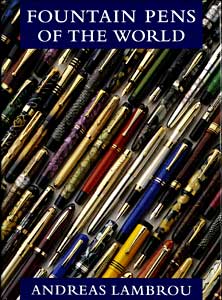|

FPOTW. Pretty much every pen collector past the “newbie” stage
recognizes that five-letter abbreviation as a shorthand way of identifying
Andreas Lambrou’s compendious Fountain Pens of the World. First
published in 1995, this 448-page coffee-table-size tome is recognized
as one of the indispensable books that form the foundation of any serious
collector’s library. Since it first appeared, FPOTW has become
the reference to which more collectors turn for definitive information
on fountain pens (produced up to the year of the book’s introduction)
than any other book.
But why, if the book has been around
for a decade, am I writing about it now? Simple. It’s back. With warehouse stocks dwindling or
sold out, FPOTW was becoming harder to get. Or else ridiculously expensive — I’ve
seen copies priced as high as $450.00 from specialty book dealers!
Mr. Lambrou, acknowledging the ubiquity of references to his book and
the continuing demand for it, has had it reprinted in a new edition
that is worth purchasing even if you already have a copy of an older
version.
Now that’s a pretty strong statement.
Here I’m telling you that it’s worth shelling out for a
book with a street price in the $150.00 range, a book that you’ve
already got. To justify this kind of expenditure, especially given
that not a word has been added or changed, there had better be something
good about this edition that isn’t intuitively obvious. There
is. Printed from new plates, on a smooth eggshell-finished paper of
higher quality than in earlier editions, this new volume offers superb
clarity of both print and photos. Text is easier on the eyes, and the
beautiful finish on the paper allows for a tremendous improvement in
color accuracy, brilliance, and depth: you can actually see the difference
between the two shades of burgundy Sheaffer used for the Snorkel (1952-1956
and 1956-1959). What? You didn’t know about the two shades of
burgundy? Now you do, and now you can see them without having to track
down the pens. And that, in a nutshell, is why the new 2005 edition
of FPOTW is worth having.
If you’ve never seen FPOTW, all
you need to know is that it is filled with text and hundreds of photos,
describing and illustrating thousands of pens — sometimes with
only minute differences between them, to help you gain a better understanding
of what you are looking at when you are buying pens or after you’ve
brought your new purchases home. There is also a treasure-trove of
information about the histories of dozens of pen companies; understanding
companies’ history can often be key to
understanding their pens. The book is exhaustively indexed — a
major plus. And it makes no attempt to waste space on assigning prices
or values to the pens it displays — another plus, given that
such values are out of date before even a brand-new book hits the shelves.
I’ve had a copy of FPOTW for
years, and I refer to it so frequently that there’s no way I
can count how many times I’ve had it off the shelf. I am now
the owner of two copies. I’m waiting for the right novice collector
to come along; then I’ll make a gift of my old copy. The
new copy? Sorry, Charlie, I’m keeping it!
|